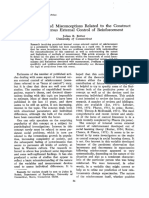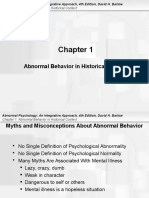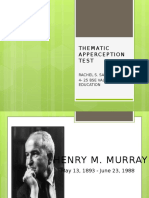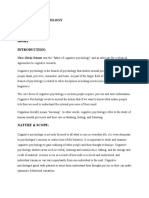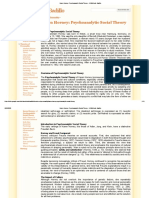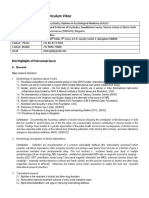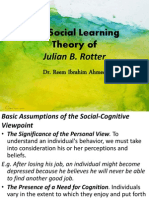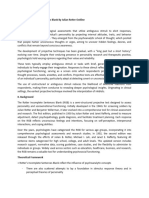Rotter's Theory of Personality
Rotter's Theory of Personality
Uploaded by
gayyerCopyright:
Available Formats
Rotter's Theory of Personality
Rotter's Theory of Personality
Uploaded by
gayyerOriginal Description:
Copyright
Available Formats
Share this document
Did you find this document useful?
Is this content inappropriate?
Copyright:
Available Formats
Rotter's Theory of Personality
Rotter's Theory of Personality
Uploaded by
gayyerCopyright:
Available Formats
Rotter's Social Learning Theory
The social learning theory is the most well-known theory of American psychologist Julian B. Rotter. The theory poses principles contrary to, and partially in reaction to, Freud's drive-based psychoanalysis, which was the dominant theory when Rotter was educated. Rotter believed that personality and behavior are products of an individual's interaction with his environment. Basic Theory In social learning theory, the environment is defined as the external stimuli that the individual recognizes and responds to, and it is viewed as a composite of learning and experiences. Because of this, the personality is seen not as a set persona, but an array of potential actions in response to external settings. Rotter's theory has four major elements: behavior potential, reinforcement value, expectancy and the psychological situation. Behavior Potential Behavior potential is a representation of the likelihood that an individual will choose a particular behavior in response to particular stimuli. In every environment, he has a selection of possible behaviors, the behavior chosen being the one with the highest behavior potential. While no personality is permanently set, the greater number of life experiences reinforcing a certain belief system, the higher the potential that he will make choices based upon that belief system. Reinforcement Value Reinforcement value is an assessment of the positive outcome of a situation. Reinforcement is a term meaning "a situation's outcome," and the higher the positive effect of an outcome, the higher its reinforcement value. The lowest reinforcement value that is still viewed as a positive outcome is called the "minimal goal" -- achieving this level or higher is viewed as success, and anything below this level of reinforcement value is viewed as failure. Expectancy Expectancy is the perceived probability that an action will result in the desired outcome. Expectancy and reinforcement value work together to determine the behavior potential of all choices in a situation. An action with a high reinforcement value (positive result) and a high expectancy (likelihood that the action will actually achieve this result) is most likely to have a high behavior potential (and so be the chosen action). The Psychological Situation Rotter actually described this relationship as a formula: BP = f (E + RV). This is merely a simplification, stating that BP (behavior potential) is a function of E (expectancy) + RV (reinforcement value). Rotter did not view this as a cut-and-dried calculation, however. Both expectancy and reinforcement value are subjective, calculated based on life experience of an individual, and not necessarily reflecting realistic or objective values. Rotter called this internal subjectivity an individual's "psychological situation," and felt it was essential to determining behavior. Treatment The most prevalent influence of Rotter's social learning theory is not seen in the teaching of psychology, but in its practice. Rotter countered the Freudian belief that behavior is instinct-driven with the belief that all behavior is learned. He therefore advocated a treatment methodology modeled after learning experiences and a teacher-student relationship. Modern cognitive behavioral treatment is rooted in this methodology.
You might also like
- Psychological Assessment-IntroductionDocument25 pagesPsychological Assessment-IntroductionthomasNo ratings yet
- BrochureDocument2 pagesBrochureapi-375895852No ratings yet
- Albert Bandura - Social Learning TheoryDocument2 pagesAlbert Bandura - Social Learning TheorygayyerNo ratings yet
- Julian RotterDocument18 pagesJulian RotterAziah ShatarNo ratings yet
- Some Problems and Misconceptions Related To The Construct of Internal Versus External Control of ReinforcementDocument12 pagesSome Problems and Misconceptions Related To The Construct of Internal Versus External Control of ReinforcementkapowNo ratings yet
- (LBY1MEA) Enriquez - Psych Assessment Flow ChartDocument3 pages(LBY1MEA) Enriquez - Psych Assessment Flow ChartjulianoenriquezNo ratings yet
- DAPT SCT HandoutDocument5 pagesDAPT SCT HandoutUdita PantNo ratings yet
- Projective Testing. Historical Foundations and Uses For Human Resources ManagementDocument14 pagesProjective Testing. Historical Foundations and Uses For Human Resources ManagementNicolás AndrésNo ratings yet
- Early Schools of PsyDocument7 pagesEarly Schools of PsyajitNo ratings yet
- Psychological Formulation and Treatment PlanDocument26 pagesPsychological Formulation and Treatment Planzwidofhela363No ratings yet
- Abnormal Chapter 1Document23 pagesAbnormal Chapter 1EsraRamosNo ratings yet
- Chapter 1 - Abnormal Behavior in Historical ContextDocument83 pagesChapter 1 - Abnormal Behavior in Historical ContextElai TampolNo ratings yet
- CT 19 PropositionsDocument2 pagesCT 19 PropositionsGentlemen PowerNo ratings yet
- Myers-Briggs Type Indicator: ManualDocument72 pagesMyers-Briggs Type Indicator: ManualJoky Satria100% (1)
- SAMSON. Rachel - HENRY MURRAY. 4-25VEDocument40 pagesSAMSON. Rachel - HENRY MURRAY. 4-25VEMs. Rachel SamsonNo ratings yet
- Cognitive Psychology NotesDocument105 pagesCognitive Psychology NotesRabeeya ArshadNo ratings yet
- Chapter 1: Introduction and Research MethodsDocument40 pagesChapter 1: Introduction and Research MethodsTawsif HasanNo ratings yet
- Overview of Holistic-Dynamic Theory: Personality, Needs Theory, and Self-Actualization TheoryDocument14 pagesOverview of Holistic-Dynamic Theory: Personality, Needs Theory, and Self-Actualization TheoryMark Jayson JuevesNo ratings yet
- Lec 1 Clinical PsychDocument9 pagesLec 1 Clinical PsychCj IsoNo ratings yet
- Henry MurrayDocument89 pagesHenry MurrayMariexell Dawn TorillaNo ratings yet
- CBT AnxietyDocument4 pagesCBT AnxietyBombey GymnectNo ratings yet
- Chapter7 Antisocial and Prosocial Behavior PDFDocument26 pagesChapter7 Antisocial and Prosocial Behavior PDFCoita Cecilia FlorinaNo ratings yet
- Relationship Between Internet Addiction and Impulsivity Among College StudentsDocument34 pagesRelationship Between Internet Addiction and Impulsivity Among College StudentsNidhi Yadv100% (1)
- Critical Review of Gordon Allport's Theoretical Work Rawd Al-TamimiDocument5 pagesCritical Review of Gordon Allport's Theoretical Work Rawd Al-TamimiRawd HalawaniNo ratings yet
- Nature and History of Clinical PsychologyDocument27 pagesNature and History of Clinical PsychologyAGLD0% (1)
- Revision Notes of Industrial and Organisational Psychology Psyc3230 Lecture 1 3Document13 pagesRevision Notes of Industrial and Organisational Psychology Psyc3230 Lecture 1 3che GamboaNo ratings yet
- Person-Centered Theory: Carl RogersDocument8 pagesPerson-Centered Theory: Carl RogersKenNo ratings yet
- Understanding Psychological AbnormalityDocument21 pagesUnderstanding Psychological AbnormalityTitikshaNo ratings yet
- The Enneagram Personality Test TruityDocument1 pageThe Enneagram Personality Test Truitythehumblepotato17.4No ratings yet
- Self Harm in AdolescenceDocument2 pagesSelf Harm in AdolescenceAmanda BrunerNo ratings yet
- Antisocial Personality Disorder - Epidemiology, Clinical Manifestations, Course and Diagnosis - UpToDateDocument17 pagesAntisocial Personality Disorder - Epidemiology, Clinical Manifestations, Course and Diagnosis - UpToDateantonia cuevas reyesNo ratings yet
- Introduction To Social Psychology RevisedDocument2 pagesIntroduction To Social Psychology RevisedbijayNo ratings yet
- TAT Report (23223065)Document70 pagesTAT Report (23223065)Sonali MishraNo ratings yet
- Psychology UGC NET StrategyDocument5 pagesPsychology UGC NET Strategylpu.sachin.singhNo ratings yet
- Theories of AggressionDocument15 pagesTheories of AggressionArva Glazel Defensor GallofinNo ratings yet
- Theories of PersonalityDocument13 pagesTheories of PersonalityAmeen ShaikNo ratings yet
- 2 Module 2 History, Cultural and Ethical ConsiderationsDocument36 pages2 Module 2 History, Cultural and Ethical ConsiderationsStiph SarteNo ratings yet
- The NEO Five-Factor Inventory Latent Structure and Relationships With Dimensions of Anxiety and Depressive Disorders in A Large Clinical SampleDocument12 pagesThe NEO Five-Factor Inventory Latent Structure and Relationships With Dimensions of Anxiety and Depressive Disorders in A Large Clinical SamplesashasalinyNo ratings yet
- 6 - CARL JUNG I 26102021 112546am 16092024 022210pmDocument22 pages6 - CARL JUNG I 26102021 112546am 16092024 022210pmAleena FatimaNo ratings yet
- Practical-2 - Eysenck's Personality QuestionnaireDocument18 pagesPractical-2 - Eysenck's Personality QuestionnairegitikaNo ratings yet
- Cross Cultural Research MethodsDocument36 pagesCross Cultural Research MethodsJoanna MabutotNo ratings yet
- Role of Attribution and Attitudes in Cognizing OthersDocument3 pagesRole of Attribution and Attitudes in Cognizing Otherssaranazer2001100% (1)
- Self-Awareness Test (Philo)Document12 pagesSelf-Awareness Test (Philo)qjannelli.22No ratings yet
- CH 13 Personality StandardisedDocument76 pagesCH 13 Personality StandardisedFyna Bob0% (1)
- CV Vivek Benegal 0610Document16 pagesCV Vivek Benegal 0610bhaskarsg0% (1)
- APA Ethical Principles and Code of ConductDocument9 pagesAPA Ethical Principles and Code of Conductsalbina arabiNo ratings yet
- QR NotesDocument88 pagesQR NotesBalaji Ravichandran100% (1)
- Psychological Statistics PART 1 REVIEWERDocument3 pagesPsychological Statistics PART 1 REVIEWERjpcarbonel.asNo ratings yet
- CDI Patient VersionDocument9 pagesCDI Patient VersionalotfyaNo ratings yet
- Psychodynamic ApproachDocument8 pagesPsychodynamic ApproachMuhammad Taha SiddiquiNo ratings yet
- Social Psychology (Chapter 6) Conformity and ObedienceDocument5 pagesSocial Psychology (Chapter 6) Conformity and ObedienceAdrian Esico Guleng100% (1)
- 2nd Testing of The Mentally Retarded PopulationDocument20 pages2nd Testing of The Mentally Retarded PopulationHoorya HashmiNo ratings yet
- Academic OptimismDocument23 pagesAcademic OptimismJay Roth100% (1)
- Psychodynamic Theories of OffendingDocument2 pagesPsychodynamic Theories of Offendingernie moreNo ratings yet
- CROSS CULTURAL Ps CH 1Document14 pagesCROSS CULTURAL Ps CH 1mekit bekele100% (1)
- Robert J. Emmerling, Psy.DDocument32 pagesRobert J. Emmerling, Psy.DPankaj Kumar srivastavaNo ratings yet
- Memoryarticles: The Three Memory Storage SystemsDocument17 pagesMemoryarticles: The Three Memory Storage SystemsZein YusufNo ratings yet
- Machover Human Figure Drawing TestDocument54 pagesMachover Human Figure Drawing TestScribdTranslations50% (2)
- Rebt DepressionDocument33 pagesRebt DepressionAmirrul ZarithNo ratings yet
- APA Code of EthicsDocument23 pagesAPA Code of EthicsCamille DavidNo ratings yet
- Introduction To Clinical and Counselling Psychology 09 - Interventions - The Basic FormsDocument43 pagesIntroduction To Clinical and Counselling Psychology 09 - Interventions - The Basic FormsRam Lifschitz100% (1)
- MPCE 014 Soft Copy by Farah QureshiDocument69 pagesMPCE 014 Soft Copy by Farah QureshiUnicorn HeartsNo ratings yet
- Depression Conceptualization and Treatment: Dialogues from Psychodynamic and Cognitive Behavioral PerspectivesFrom EverandDepression Conceptualization and Treatment: Dialogues from Psychodynamic and Cognitive Behavioral PerspectivesChristos CharisNo ratings yet
- Let Me Fix It MyselfDocument1 pageLet Me Fix It MyselfgayyerNo ratings yet
- Personality TheoriesDocument33 pagesPersonality TheoriesmagicalseasNo ratings yet
- Chapter14 - PersonalityDocument22 pagesChapter14 - PersonalitygayyerNo ratings yet
- The Viscount and The Hoyden - Laura MatthewsDocument45 pagesThe Viscount and The Hoyden - Laura Matthewsgayyer33% (3)
- Lyrics For Que Cera CeraDocument2 pagesLyrics For Que Cera CeragayyerNo ratings yet
- The Viscount and The Hoyden - Laura MatthewsDocument45 pagesThe Viscount and The Hoyden - Laura Matthewsgayyer33% (3)
- Rotters Incomplete Sentences Blank by Julian Rotter OutlineDocument8 pagesRotters Incomplete Sentences Blank by Julian Rotter OutlineesporlassophiamaeNo ratings yet
- The Social Learning Theory of RotterDocument32 pagesThe Social Learning Theory of Rotterumibrahim50% (2)
- Rotter and MischellDocument3 pagesRotter and MischellangeluNo ratings yet
- I. Overview of Cognitive Social Learning TheoryDocument4 pagesI. Overview of Cognitive Social Learning TheorynitinandsubahNo ratings yet
- Rotter's Theory of PersonalityDocument1 pageRotter's Theory of Personalitygayyer100% (3)
- Social Learning Theory by Julian RotterDocument16 pagesSocial Learning Theory by Julian RotterMarry Jane Rivera Sioson0% (1)
- Locus of ControlDocument36 pagesLocus of ControlMohamad Saleh Abdul Rahman100% (1)
- Essay On Endangered SpeciesDocument6 pagesEssay On Endangered Speciesafabilalf100% (2)
- HesisDocument101 pagesHesisKyle AksionovNo ratings yet
- Ch. 18 Rotter and Mischel PDFDocument19 pagesCh. 18 Rotter and Mischel PDFJayc SaleraNo ratings yet
- Rotters Incomplete Sentences Blank by Julian Rotter OutlineDocument10 pagesRotters Incomplete Sentences Blank by Julian Rotter OutlineesporlassophiamaeNo ratings yet
- JB Rotter 1990 PDFDocument5 pagesJB Rotter 1990 PDFsiti sundariNo ratings yet
- Locus of ControlDocument12 pagesLocus of ControlmansiNo ratings yet
- The Social Learning Theory of Rotter-231012 - 101305Document6 pagesThe Social Learning Theory of Rotter-231012 - 101305Rizz GynNo ratings yet
- Biography of Julian RotterDocument3 pagesBiography of Julian RotterWarren GreyNo ratings yet
- Biography of Julian RotterDocument12 pagesBiography of Julian RotterEllie BunNo ratings yet




